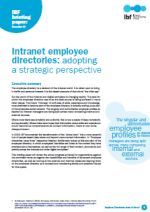Is your intranet’s employee directory an endangered species?
I’ve just completed a briefing paper for DWG and, I have to say, it’s been intriguing. I was asked to look at that stalwart, the employee directory, and what I found worried me.
An unfulfilled promise
 A few years ago we knew where our favourite killer app was heading. It was going to be transformed from the boring old phonebook into an amazing view of everything about your colleagues. We were going to be able to see their picture (wow!), and lots of other cool stuff like their skills and their experience. We were going to be able see everything about their digital life within an organization: what groups they belonged to, what documents they’d published and how they were connected to everyone else. The future was sunny indeed.
A few years ago we knew where our favourite killer app was heading. It was going to be transformed from the boring old phonebook into an amazing view of everything about your colleagues. We were going to be able to see their picture (wow!), and lots of other cool stuff like their skills and their experience. We were going to be able see everything about their digital life within an organization: what groups they belonged to, what documents they’d published and how they were connected to everyone else. The future was sunny indeed.
Whilst there are some very good employee directories out there, it looks like everything is a lot less rosy for everyone else. There is disappointment in the air. People aren’t updating their profiles. The advanced features aren’t getting used. What’s going on?
Well, a few things have changed in the past few years.
Profile proliferation and integration barriers
Online personal profiles were once a rarity and now people have half a dozen, internally and externally. Some they polish with great attention (LinkedIn), while internal profiles on employee directories tend to languish unattended. Organizations at first push employees to populate them with photos and other rich data, and then need to push them again and again to keep it updated.
If your organization chose a cloud-based enterprise social network like Yammer or Chatter, it’s likely you have two profiles that are now competing with each other, with partial data that is out of sync. Also any view of the employee’s digital activity (in SharePoint-land anyway) has frankly tended to stop at the boundary of the content management system. What happens in SharePoint stays in SharePoint. Connectors are coming but they add complexity and are another thing to go wrong.
In the vast majority of large organizations the basic and essential information you need to contact your colleague is now in the Microsoft Active Directory. This means that you can usually get this data straight from Microsoft Outlook and, increasingly, from the Microsoft Lync instant messaging client, right there on the desktop.
So we’ve got a quandary. How are you going to convince your colleagues to update their profile in the employee directory, when it is just one of many? Other profiles are far more hip and everyone gets email address and phone numbers using Outlook and Lync.
When the directory’s view across the organization stops at the edge of SharePoint, the future doesn’t look so bright, does it?
Time to rethink employee directories
The future will be, I think, possibly different. In the research paper, we look at the ways in which some of the problems that I have mentioned above can be mitigated, but I also address alternative ways of considering the problem:
- What can we learn from the empirical evidence of nearly 40 IBF benchmarking evaluations?
- What are the limits to self-maintained data and what are the alternatives?
- Can we automate expertise location? And if we can, what are the potential drawbacks?
- Are people looking for expertise? Should the employee directory stick to phone numbers?
- What’s the future for the employee directory? Will it disappear, and be subsumed into the enterprise social network?
With three case notes from experiences at two major financial institutions and a pharmaceutical company this report provides an honest, real-world look at the state of intranet employee directories.
If you’ve been disappointed with the evolution of your intranet employee directory, know that you are not alone and that there are practical resources for improving your situation.
IBF members can access the report on the IBF member extranet. Everyone else can download a report summary.
[ctaleft]Get copy of report summary[/ctaleft]
Categorised in: Collaboration, HR intranets, Intranets, Research reports, Strategy & governance
